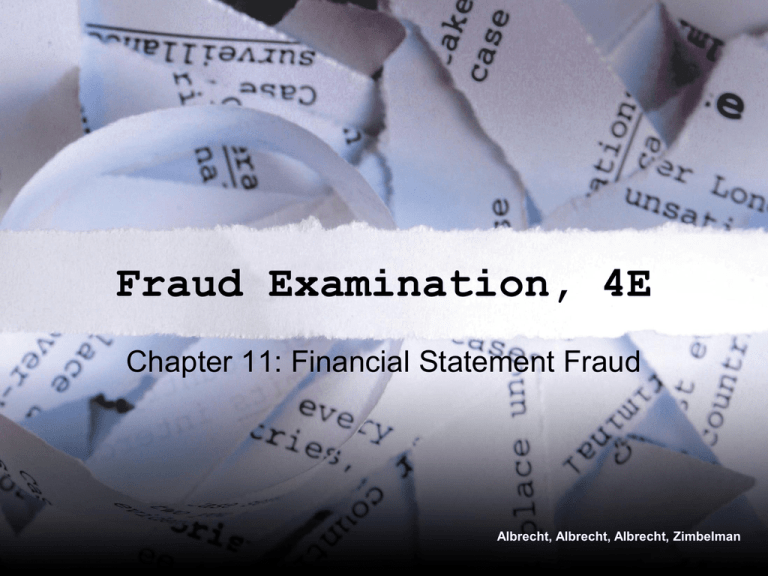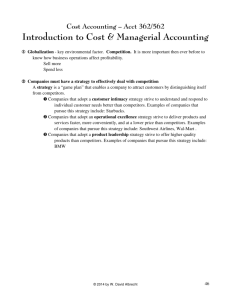
Fraud Examination, 4E
Chapter 11: Financial Statement Fraud
Albrecht, Albrecht, Albrecht, Zimbelman
Learning Objectives
Discuss the role that financial statements play in
capital markets.
Understand the nature of financial statement
fraud.
Become familiar with financial statement fraud
statistics.
See how financial statement frauds occur and are
concealed.
Outline the framework for detecting financial
statement fraud.
Albrecht, Albrecht, Albrecht, Zimbelman
© 2011 Cengage Learning. All Rights Reserved. May not be copied, scanned, or duplicated, in whole or in part, except for use as permitted in a license
Learning Objectives
Identify financial statement fraud exposures.
Explain how information regarding a company’s
management and directors, nature of
organization, operating characteristics,
relationship with others, and financial results can
help assess the likelihood of financial statement
fraud.
Albrecht, Albrecht, Albrecht, Zimbelman
© 2011 Cengage Learning. All Rights Reserved. May not be copied, scanned, or duplicated, in whole or in part, except for use as permitted in a license
Role of Financial Statements
Financial statements play
a very important role in
keeping capital markets
efficient.
Financial statements are
based on generally
accepted accounting
principles (GAAP), which
guide the accounting for
transactions.
Albrecht, Albrecht, Albrecht, Zimbelman
© 2011 Cengage Learning. All Rights Reserved. May not be copied, scanned, or duplicated, in whole or in part, except for use as permitted in a license
Financial Statement Fraud
Financial statements are sometimes prepared in
ways that intentionally misstate the financial
position and performance of an organization.
Misstatement of financial statements can result
from manipulating, falsifying, or altering
accounting records.
Misleading financial statements cause serious
problems in the market and the economy.
Albrecht, Albrecht, Albrecht, Zimbelman
© 2011 Cengage Learning. All Rights Reserved. May not be copied, scanned, or duplicated, in whole or in part, except for use as permitted in a license
Financial Statement Fraud
Misleading financial
statements cause
serious problems:
large losses by investors
lack of trust in the market
and accounting systems
litigation and
embarrassment for
individuals and
organizations associated
with financial statement
fraud
Albrecht, Albrecht, Albrecht, Zimbelman
© 2011 Cengage Learning. All Rights Reserved. May not be copied, scanned, or duplicated, in whole or in part, except for use as permitted in a license
Examples of Financial
Statement Fraud
Misstated financial
statements and
“cooking the books.”
Examples:
Qwest
Enron
Global Crossing
WorldCom
Xerox
Albrecht, Albrecht, Albrecht, Zimbelman
© 2011 Cengage Learning. All Rights Reserved. May not be copied, scanned, or duplicated, in whole or in part, except for use as permitted in a license
Examples of Financial
Statement Fraud
Inappropriate executive loans and corporate
looting.
Examples:
John Rigas (Adelphia)
Dennis Kozlowski (Tyco)
Bernie Ebbers (WorldCom)
Albrecht, Albrecht, Albrecht, Zimbelman
© 2011 Cengage Learning. All Rights Reserved. May not be copied, scanned, or duplicated, in whole or in part, except for use as permitted in a license
Examples of Financial
Statement Fraud
Insider trading
scandals
Example:
Martha Stewart and
Sam Waksal, both
used insider
information to profit
from trading
ImClone stock
Albrecht, Albrecht, Albrecht, Zimbelman
© 2011 Cengage Learning. All Rights Reserved. May not be copied, scanned, or duplicated, in whole or in part, except for use as permitted in a license
Why These Frauds Occurred
Albrecht, Albrecht, Albrecht, Zimbelman
© 2011 Cengage Learning. All Rights Reserved. May not be copied, scanned, or duplicated, in whole or in part, except for use as permitted in a license
Elements of the Perfect
Fraud Storm
A Booming Economy
Decay of Moral Values
Misplaced Incentives
High Analysts’ Expectations
High Debt Levels
Focus on Accounting Rules Rather Than Principles
Lack of Auditor Independence
Greed
Educator Failures
Albrecht, Albrecht, Albrecht, Zimbelman
© 2011 Cengage Learning. All Rights Reserved. May not be copied, scanned, or duplicated, in whole or in part, except for use as permitted in a license
Nature of Financial
Statement Fraud
Involves intentional deceit
Involves attempted concealment
Rarely seen
Many false red flags
Conviction is very difficult
Because of the difficulty of detecting and proving fraud , investigators must exercise
extreme care when performing fraud examinations, quantifying fraud, or performing
other types of fraud-related engagements.
Albrecht, Albrecht, Albrecht, Zimbelman
© 2011 Cengage Learning. All Rights Reserved. May not be copied, scanned, or duplicated, in whole or in part, except for use as permitted in a license
Fraud Statistics (Between
1987 – 1997)
The average fraud last about two years
Improper revenue recognition, overstatement of
assets, and understatement of expenses were
the most common frauds
Cumulative average magnitude of fraud was $25
million ($4.1 million median)
CEO perpetrated the fraud in 72 percent of the
cases
Albrecht, Albrecht, Albrecht, Zimbelman
© 2011 Cengage Learning. All Rights Reserved. May not be copied, scanned, or duplicated, in whole or in part, except for use as permitted in a license
Fraud Statistics (Between
1987 – 1997)
Fraudulent companies’ size: Average assets were
$532 million ($16 million median) and $232 million
average revenues ($13 million median)
Severe consequences were usually associated
with companies having fraudulent financial
statements
Most of these firms had no audit committee, or
one that met only once per year
Albrecht, Albrecht, Albrecht, Zimbelman
© 2011 Cengage Learning. All Rights Reserved. May not be copied, scanned, or duplicated, in whole or in part, except for use as permitted in a license
Fraud Statistics (Between
1987 – 1997)
Boards of directors were dominated by insiders
and “grey” directors
Some companies were experiencing net losses or
were close to break-even positions
25% of the companies changed auditors during
the fraud period
Albrecht, Albrecht, Albrecht, Zimbelman
© 2011 Cengage Learning. All Rights Reserved. May not be copied, scanned, or duplicated, in whole or in part, except for use as permitted in a license
Detecting Financial
Statement Fraud
Strategic Reasoning
The ability to anticipate a fraud perpetrator’s likely method
of concealing a fraud
Albrecht, Albrecht, Albrecht, Zimbelman
© 2011 Cengage Learning. All Rights Reserved. May not be copied, scanned, or duplicated, in whole or in part, except for use as permitted in a license
Detecting Financial
Statement Fraud
Strategic Reasoning
Questions to ask:
What types of fraud schemes is management likely to
use to commit financial statement fraud?
What typical tests are used to detect these schemes?
How could management conceal the scheme of interest
from the typical test?
How could the typical test be modified so as to detect
the concealed scheme?
Albrecht, Albrecht, Albrecht, Zimbelman
© 2011 Cengage Learning. All Rights Reserved. May not be copied, scanned, or duplicated, in whole or in part, except for use as permitted in a license
Detecting Financial
Statement Fraud
Financial Statement
Analysis
Focus on the changes in
reported assets, liabilities,
revenues, and expenses
from period to period or by
comparing company
performance to industry
norms.
Not just general financial
statement analysis –
think outside the box……
Albrecht, Albrecht, Albrecht, Zimbelman
© 2011 Cengage Learning. All Rights Reserved. May not be copied, scanned, or duplicated, in whole or in part, except for use as permitted in a license
Detecting Financial
Statement Fraud
Nonfinancial Performance Measures
Look for a discrepancy between the company’s
financial and nonfinancial performance
Example:
Former HealthSouth CEO Richard Scrushy’s
The company’s revenues and assets were increasing
while the number of HealthSouth facilities decreased
Albrecht, Albrecht, Albrecht, Zimbelman
© 2011 Cengage Learning. All Rights Reserved. May not be copied, scanned, or duplicated, in whole or in part, except for use as permitted in a license
Detecting Financial
Statement Fraud
Albrecht, Albrecht, Albrecht, Zimbelman
© 2011 Cengage Learning. All Rights Reserved. May not be copied, scanned, or duplicated, in whole or in part, except for use as permitted in a license
Management and Directors
Investigate three aspects of management:
Managements’ backgrounds
Managements’ motivations
Managements’ influence in making decisions for the
organization
Albrecht, Albrecht, Albrecht, Zimbelman
© 2011 Cengage Learning. All Rights Reserved. May not be copied, scanned, or duplicated, in whole or in part, except for use as permitted in a license
Relationship with Others
Relationships should be examined to determine if they
present management fraud opportunities or exposures.
Carefully consider relationships with:
related organizations and individuals
external auditors
lawyers
Investors
regulators
bondholders
Albrecht, Albrecht, Albrecht, Zimbelman
© 2011 Cengage Learning. All Rights Reserved. May not be copied, scanned, or duplicated, in whole or in part, except for use as permitted in a license
Organization and Industry
Some industries are more risky than others.
Attributes of fraud-prone organizations:
unduly complex organizational structure
without an internal audit department
board of directors with no or few outsiders on the board or audit
committee
one person or a small group of individuals controls related entities
has offshore affiliates with no apparent business purpose
Albrecht, Albrecht, Albrecht, Zimbelman
© 2011 Cengage Learning. All Rights Reserved. May not be copied, scanned, or duplicated, in whole or in part, except for use as permitted in a license
Financial Results and
Operations
Critical questions that must be asked:
Are unrealistic changes or increases present in
financial statement account balances?
Are account balances are not realistic given the nature,
age, and size of the company?
Do actual physical assets do not exist in the amounts
and values indicated on the financial statements?
Have there been significant changes in the nature of
the organization’s revenues or expenses?
Albrecht, Albrecht, Albrecht, Zimbelman
© 2011 Cengage Learning. All Rights Reserved. May not be copied, scanned, or duplicated, in whole or in part, except for use as permitted in a license




